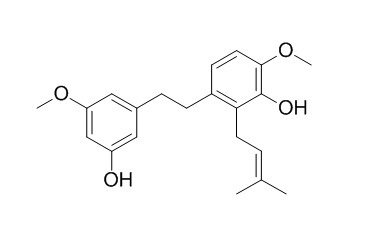Canniprene
Canniprene has anti-inflammatory activity, it can potently inhibit the production of inflammatory eicosanoids via the 5-lipoxygenase pathway (IC50=0.4uM) and also can affect the generation of prostaglandins via the cyclooxygenase/microsomal prostaglandin E2 synthase pathway (IC50 =10 uM).
Inquire / Order:
manager@chemfaces.com
Technical Inquiries:
service@chemfaces.com
Tel:
+86-27-84237783
Fax:
+86-27-84254680
Address:
1 Building, No. 83, CheCheng Rd., Wuhan Economic and Technological Development Zone, Wuhan, Hubei 430056, PRC
Providing storage is as stated on the product vial and the vial is kept tightly sealed, the product can be stored for up to
24 months(2-8C).
Wherever possible, you should prepare and use solutions on the same day. However, if you need to make up stock solutions in advance, we recommend that you store the solution as aliquots in tightly sealed vials at -20C. Generally, these will be useable for up to two weeks. Before use, and prior to opening the vial we recommend that you allow your product to equilibrate to room temperature for at least 1 hour.
Need more advice on solubility, usage and handling? Please email to: service@chemfaces.com
The packaging of the product may have turned upside down during transportation, resulting in the natural compounds adhering to the neck or cap of the vial. take the vial out of its packaging and gently shake to let the compounds fall to the bottom of the vial. for liquid products, centrifuge at 200-500 RPM to gather the liquid at the bottom of the vial. try to avoid loss or contamination during handling.
Antioxidants (Basel).2020, 9(4):284.
Front Pharmacol.2018, 9:756
Fitoterapia.2024, 106006.
Biochem Systematics and Ecology2017, 11-18
Chinese Pharmaceutical Journal2023, 58(2):178-187.
Sci Rep.2023, 13(1):21690.
Molecular & Cellular Toxicology2017, 13(3):271-278
J Biomol Struct Dyn.2022, 1-21.
Food Chem.2023, 427:136647.
Research Square2020, doi: 10.21203.
Related and Featured Products
J Nat Prod. 2017 Mar 24;80(3):731-734.
The Bibenzyl Canniprene Inhibits the Production of Pro-Inflammatory Eicosanoids and Selectively Accumulates in Some Cannabis sativa Strains.[Pubmed:
28165233 ]
Canniprene (1), an isoprenylated bibenzyl unique to Cannabis sativa, can be vaporized and therefore potentially inhaled from marijuana.
METHODS AND RESULTS:
Canniprene (1) potently inhibited the production of inflammatory eicosanoids via the 5-lipoxygenase pathway (IC50 0.4 μM) and also affected the generation of prostaglandins via the cyclooxygenase/microsomal prostaglandin E2 synthase pathway (IC50 10 μM), while the related spiranoid bibenzyls cannabispiranol (2) and cannabispirenone (3) were almost inactive in these bioassays. The concentration of Canniprene (1) was investigated in the leaves of 160 strains of C. sativa, showing wide variations, from traces to >0.2%, but no correlation was found between its accumulation and a specific phytocannabinoid profile.
Bull Narc. 1982 Apr-Jun;34(2):51-6.
Constituents of Cannabis sativa L. XXII: isolation of spiro-indan and dihydrostilbene compounds from a Panamanian variant grown in Mississippi, United States of America.[Pubmed:
6924596]
METHODS AND RESULTS:
Three spiro-compounds, namely cannabispiran, dehydrocannabispiran and beta-cannabispiranol, and 2 dihydrostilbenes [3-(2-(3-hydroxy-4-methoxyphenyl)ethyl)-5-methoxyphenol and Canniprene] were isolated from a polar fraction of a Panamanian variant of Cannabis sativa L. grown in Mississippi, United States of America. The plant material was extracted with 95% ethanol and the dried ethanol extract was then partitioned between chloroform and water. The chloroform fraction was fractionated between hexane and 3N sodium hydroxide solution. Acidification of the basic fraction followed by extraction with ether afforded a polar acidic fraction from which the above-mentioned compounds were isolated through repeated chromatography.
CONCLUSIONS:
The structures of the above compounds were determined by spectral means as well as by comparison with reference samples.
The isolation of two dihydrostilbenes and three spiro-indan compounds from a single variant provides good support that the dihydrostilbenes are the natural precursors to the spiro-indan compounds.



